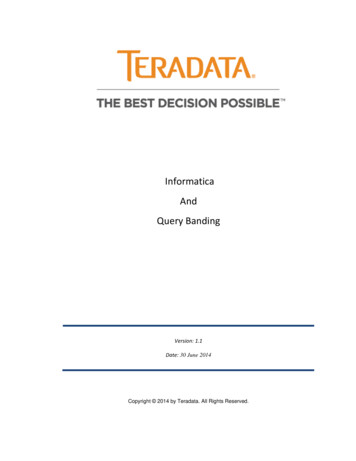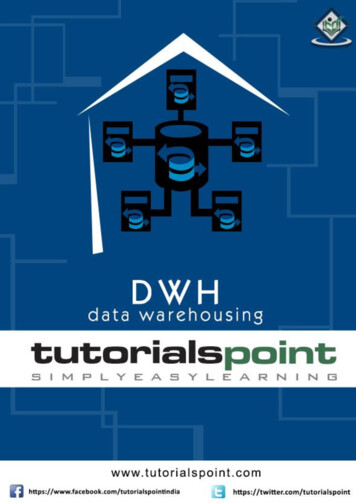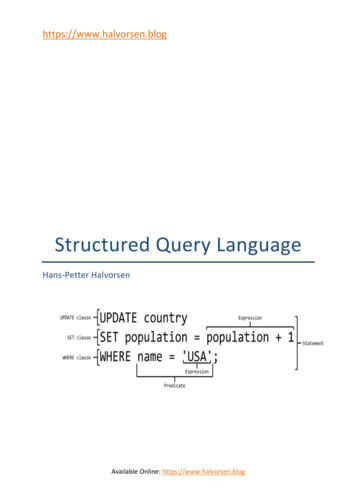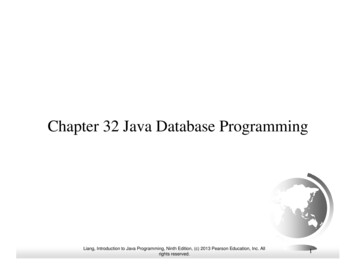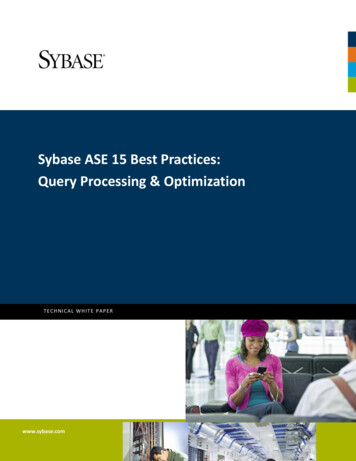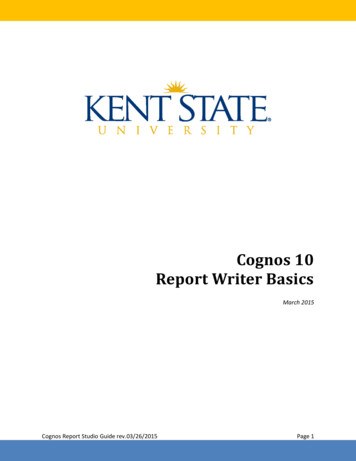![[MS-KQL]: Keyword Query Language Structure Protocol](/img/18/ms-kql.jpg)
Transcription
[MS-KQL]:Keyword Query Language Structure ProtocolIntellectual Property Rights Notice for Open Specifications Documentation Technical Documentation. Microsoft publishes Open Specifications documentation (“thisdocumentation”) for protocols, file formats, data portability, computer languages, and standardssupport. Additionally, overview documents cover inter-protocol relationships and interactions.Copyrights. This documentation is covered by Microsoft copyrights. Regardless of any otherterms that are contained in the terms of use for the Microsoft website that hosts thisdocumentation, you can make copies of it in order to develop implementations of the technologiesthat are described in this documentation and can distribute portions of it in your implementationsthat use these technologies or in your documentation as necessary to properly document theimplementation. You can also distribute in your implementation, with or without modification, anyschemas, IDLs, or code samples that are included in the documentation. This permission alsoapplies to any documents that are referenced in the Open Specifications documentation.No Trade Secrets. Microsoft does not claim any trade secret rights in this documentation.Patents. Microsoft has patents that might cover your implementations of the technologiesdescribed in the Open Specifications documentation. Neither this notice nor Microsoft's delivery ofthis documentation grants any licenses under those patents or any other Microsoft patents.However, a given Open Specifications document might be covered by the Microsoft OpenSpecifications Promise or the Microsoft Community Promise. If you would prefer a written license,or if the technologies described in this documentation are not covered by the Open SpecificationsPromise or Community Promise, as applicable, patent licenses are available by contactingiplg@microsoft.com.License Programs. To see all of the protocols in scope under a specific license program and theassociated patents, visit the Patent Map.Trademarks. The names of companies and products contained in this documentation might becovered by trademarks or similar intellectual property rights. This notice does not grant anylicenses under those rights. For a list of Microsoft trademarks, visitwww.microsoft.com/trademarks.Fictitious Names. The example companies, organizations, products, domain names, emailaddresses, logos, people, places, and events that are depicted in this documentation are fictitious.No association with any real company, organization, product, domain name, email address, logo,person, place, or event is intended or should be inferred.Reservation of Rights. All other rights are reserved, and this notice does not grant any rights otherthan as specifically described above, whether by implication, estoppel, or otherwise.Tools. The Open Specifications documentation does not require the use of Microsoft programmingtools or programming environments in order for you to develop an implementation. If you have accessto Microsoft programming tools and environments, you are free to take advantage of them. CertainOpen Specifications documents are intended for use in conjunction with publicly available standardsspecifications and network programming art and, as such, assume that the reader either is familiarwith the aforementioned material or has immediate access to it.Support. For questions and support, please contact dochelp@microsoft.com.1 / 29[MS-KQL] - v20220215Keyword Query Language Structure ProtocolCopyright 2022 Microsoft CorporationRelease: February 15, 2022
Revision 0/20120.1NewReleased new document.4/11/20120.1NoneNo changes to the meaning, language, or formatting of thetechnical content.7/16/20120.1NoneNo changes to the meaning, language, or formatting of thetechnical content.9/12/20120.1NoneNo changes to the meaning, language, or formatting of thetechnical content.10/8/20121.0MajorSignificantly changed the technical content.2/11/20132.0MajorSignificantly changed the technical content.7/30/20132.0NoneNo changes to the meaning, language, or formatting of thetechnical content.11/18/20132.0NoneNo changes to the meaning, language, or formatting of thetechnical content.2/10/20142.0NoneNo changes to the meaning, language, or formatting of thetechnical content.4/30/20142.0NoneNo changes to the meaning, language, or formatting of thetechnical content.7/31/20142.0NoneNo changes to the meaning, language, or formatting of thetechnical content.10/30/20142.0NoneNo changes to the meaning, language, or formatting of thetechnical content.2/26/20163.0MajorSignificantly changed the technical content.7/15/20163.0NoneNo changes to the meaning, language, or formatting of thetechnical content.9/14/20163.0NoneNo changes to the meaning, language, or formatting of thetechnical content.9/29/20163.0NoneNo changes to the meaning, language, or formatting of thetechnical content.10/17/20163.0NoneNo changes to the meaning, language, or formatting of thetechnical content.7/24/20184.0MajorSignificantly changed the technical content.10/1/20185.0MajorSignificantly changed the technical content.7/20/20216.0MajorSignificantly changed the technical content.10/5/20217.0MajorSignificantly changed the technical content.2/15/20227.0NoneNo changes to the meaning, language, or formatting of thetechnical content.2 / 29[MS-KQL] - v20220215Keyword Query Language Structure ProtocolCopyright 2022 Microsoft CorporationRelease: February 15, 2022
Table of Contents1Introduction . 51.1Glossary . 51.2References . 61.2.1Normative References . 61.2.2Informative References . 61.3Overview . 61.4Relationship to Protocols and Other Structures . 61.5Applicability Statement . 61.6Versioning and Localization . 71.7Vendor-Extensible Fields . 72Structures . 82.1Operators. 102.1.1ALL Operator. 102.1.2AND Operator . 102.1.3ANY Operator . 102.1.4NEAR Operator . 102.1.5NONE Operator . 112.1.6NOT Operator . 112.1.7ONEAR Operator . 112.1.8OR Operator . 112.1.9WORDS Operator . 112.1.10XRANK Operator . 112.1.10.1XRANK Formula . 122.1.11Implicit Operator . 122.1.12Parentheses . 132.1.13Operator Precedence and Associativity . 132.2Property Restrictions . 132.2.1Property Values . 142.2.2Property Ranges . 142.2.3Property Qualification . 142.2.4Implicit Operator for Property Restrictions . 142.3Tokens. 152.3.1String Tokens . 152.3.1.1Qualified String Tokens . 152.3.1.1.1Implicit AND operator . 152.3.1.1.2Implicit OR operator . 152.3.1.2String Token Prefix. 162.3.2Boolean Tokens . 162.3.3Integer Tokens . 162.3.4Float Tokens . 162.3.5Date Tokens. 173Structure Examples . 183.1Operators. 183.1.1ALL Operator. 183.1.2AND Operator . 183.1.3ANY Operator . 183.1.4NEAR Operator . 183.1.5NONE Operator . 183.1.6NOT Operator . 193.1.7ONEAR Operator . 193.1.8OR Operator . 193.1.9WORDS Operator . 193.1.10XRANK Operator . 203 / 29[MS-KQL] - v20220215Keyword Query Language Structure ProtocolCopyright 2022 Microsoft CorporationRelease: February 15, 2022
3.1.11Implicit Operator . 203.1.12Parentheses . 203.2Property Restrictions . 203.2.1Property Range . 203.2.2Property Qualification . 213.2.3Implicit Operator for Property Restriction . 213.3Tokens. 213.3.1String Tokens . 213.3.1.1Qualified String Tokens . 223.3.1.1.1Implicit AND Operator . 223.3.1.1.2Implicit OR Operator . 223.3.1.2String Token Prefix. 223.3.2Boolean Tokens . 233.3.3Integer Tokens . 233.3.4Float Tokens . 233.3.5Date Tokens. 234Security . 254.1Security Considerations for Implementers . 254.2Index of Security Fields . 255Appendix A: Product Behavior . 266Change Tracking . 277Index . 284 / 29[MS-KQL] - v20220215Keyword Query Language Structure ProtocolCopyright 2022 Microsoft CorporationRelease: February 15, 2022
1IntroductionThis document specifies the structure of the Keyword Query Language (KQL). KQL is a language forexpressing search criteria.Sections 1.7 and 2 of this specification are normative. All other sections and examples in thisspecification are informative.1.1GlossaryThis document uses the following terms:Augmented Backus-Naur Form (ABNF): A modified version of Backus-Naur Form (BNF),commonly used by Internet specifications. ABNF notation balances compactness and simplicitywith reasonable representational power. ABNF differs from standard BNF in its definitions anduses of naming rules, repetition, alternatives, order-independence, and value ranges. For moreinformation, see [RFC5234].Boolean: An operation or expression that can be evaluated only as either true or false.Coordinated Universal Time (UTC): A high-precision atomic time standard that approximatelytracks Universal Time (UT). It is the basis for legal, civil time all over the Earth. Time zonesaround the world are expressed as positive and negative offsets from UTC. In this role, it is alsoreferred to as Zulu time (Z) and Greenwich Mean Time (GMT). In these specifications, allreferences to UTC refer to the time at UTC-0 (or GMT).dynamic rank: A rank component that indicates how well query text matches an indexed item.See also static rank.item: A unit of content that can be indexed and searched by a search application.managed property: A specific property that is part of a metadata schema. It can be exposed foruse in search queries that are executed from the user interface.metadata schema: A schema that is used to manage information about an item.query text: The textual, string portion of a query.rank: An integer that represents the relevance of a specific item for a search query. It can be acombination of static rank and dynamic rank. See also static rank and dynamic rank.result set: A list of records that results from running a stored procedure or query, or applying afilter. The structure and content of the data in a result set varies according to theimplementation.time zone: A geographical area that observes the same local time. The local time has a positive,zero, or negative offset from Coordinated Universal Time (UTC). The offset can be differentduring standard time and daylight saving time.token: A word in an item or a search query that translates into a meaningful word or number inwritten text. A token is the smallest textual unit that can be matched in a search query.Examples include "cat", "AB14", or "42".Unicode: A character encoding standard developed by the Unicode Consortium that representsalmost all of the written languages of the world. The Unicode standard [UNICODE5.0.0/2007]provides three forms (UTF-8, UTF-16, and UTF-32) and seven schemes (UTF-8, UTF-16, UTF-16BE, UTF-16 LE, UTF-32, UTF-32 LE, and UTF-32 BE).5 / 29[MS-KQL] - v20220215Keyword Query Language Structure ProtocolCopyright 2022 Microsoft CorporationRelease: February 15, 2022
UTF-8: A byte-oriented standard for encoding Unicode characters, defined in the Unicode standard.Unless specified otherwise, this term refers to the UTF-8 encoding form specified in[UNICODE5.0.0/2007] section 3.9.MAY, SHOULD, MUST, SHOULD NOT, MUST NOT: These terms (in all caps) are used as definedin [RFC2119]. All statements of optional behavior use either MAY, SHOULD, or SHOULD NOT.1.2ReferencesLinks to a document in the Microsoft Open Specifications library point to the correct section in themost recently published version of the referenced document. However, because individual documentsin the library are not updated at the same time, the section numbers in the documents may notmatch. You can confirm the correct section numbering by checking the Errata.1.2.1 Normative ReferencesWe conduct frequent surveys of the normative references to assure their continued availability. If youhave any issue with finding a normative reference, please contact dochelp@microsoft.com. We willassist you in finding the relevant information.[RFC2119] Bradner, S., "Key words for use in RFCs to Indicate Requirement Levels", BCP 14, RFC2119, March 1997, http://www.rfc-editor.org/rfc/rfc2119.txt[RFC5234] Crocker, D., Ed., and Overell, P., "Augmented BNF for Syntax Specifications: ABNF", STD68, RFC 5234, January 2008, http://www.rfc-editor.org/rfc/rfc5234.txt1.2.2 Informative References[MS-FQL2] Microsoft Corporation, "Fast Query Language Version 2 Protocol".[MS-SEARCH] Microsoft Corporation, "Search Protocol".1.3OverviewApplication implementers and end users use KQL to express criteria for searching. A typical scenariofor using KQL is an application that enables users to search for items and browse through results.KQL specifies a syntax for search queries that enables users and application implementers toformulate search queries in a structure that resembles natural language and at the same time allowsthe specification of Boolean matching rules on text and properties of the searched items.A KQL expression consists of search tokens, operators, and property restrictions. A search tokenconsists of a value or a range of values to search for, and an operator specifies how to include,exclude, and rank the search results. Examples of operators include AND, OR, NOT, NEAR, andXRANK. A property restriction specifies a Boolean predicate on one property of the searched items.1.4Relationship to Protocols and Other StructuresThe Search Protocol uses KQL as described in [MS-SEARCH].An FQL string token supports a KQL mode, FQL is described in [MS-FQL2].1.5Applicability StatementKQL is intended for both application implementers and end users. Application implementers use KQLfor searches when they use the Search protocol as described in [MS-SEARCH]. End users typically useKQL for entering search criteria in a search input field in an application.6 / 29[MS-KQL] - v20220215Keyword Query Language Structure ProtocolCopyright 2022 Microsoft CorporationRelease: February 15, 2022
1.6Versioning and LocalizationNone.1.7Vendor-Extensible FieldsNone.7 / 29[MS-KQL] - v20220215Keyword Query Language Structure ProtocolCopyright 2022 Microsoft CorporationRelease: February 15, 2022
2StructuresA KQL expression consists of search tokens, operators, and property restrictions. A search tokenconsists of a value or a range of values to search for, and an operator specifies how to include,exclude, and rank the search results. A property restriction specifies a Boolean predicate on oneproperty of the searched items.KQL operators are case sensitive, and operators use uppercase. Some operators are placed betweenoperands, and other operators are placed before operands. Where noted in the following subsections,operators can have parameters that are placed after the operator in parentheses.The following words are operators: ALL AND ANY NEAR NONE NOT ONEAR OR WORDS XRANKA special class of operators, property operators, is used for property restrictions. The following areproperty operators: : The structure of a KQL expression corresponds to the following rules, which themselves conform toAugmented Backus-Naur Form (ABNF) as specified in [RFC5234].kql-expression (operator-expression / expression-list)expression-list (operator-expression operator-expression)/ (expression-list operator-expression)operator-expression (all / and / any / near / none / not / onear/ or / words / xrank / basic-expression / paren-expression)paren-expression "(" kql-expression ")"8 / 29[MS-KQL] - v20220215Keyword Query Language Structure ProtocolCopyright 2022 Microsoft CorporationRelease: February 15, 2022
basic-expression ([qualification] unquoted-string-value)/ ([qualification] quoted-string-value)/ property-restriction; Operator expressionsall "ALL" "(" 1*string-value ")"and operator-expression "AND" operator-expressionany "ANY" "(" 1*string-value ")"none "NONE" "(" 1*string-value ")"not "NOT" operator-expressionor operator-expression "OR" operator-expressionnear operator-expression "NEAR" [proximity-param] operator-expressiononear operator-expression "ONEAR" [proximity-param] operator-expressionproximity-param "(" [["N" " "] integer-value] ")"words "WORDS" "(" words-param-list ")"words-param-list words-param *([","] words-param)words-param [qualification] string-valuexrank operator-expression "XRANK" "(" xrank-param-list ")" operator-expressionxrank-param-list xrank-param *([","] xrank-param)xrank-param ("pb" " " float-value)/ ("rb" " " float-value)/ ("cb" " " float-value)/ ("avgb" " " float-value)/ ("stdb" " " float-value)/ ("nb" " " float-value)/ ("n" " " integer-value); Property restrictionproperty-restriction [qualification]property-name property-operator property-valueproperty-name property-token / quoted-string-valueproperty-token 1*(%x30-39 / %x41-5a / %x5f / %x61-7a / %xaa / %xb5 / %xba/ %xc0-d6 / %xe0-ffffffff)property-value property-typed-value/ unquoted-property-token/ quoted-string-valueproperty-operator ":" / " " / " " / " " / " "/ " " / " "unquoted-property-token 1*(%x01-08 / %x0b-0c / %x0e-1f / %x21 / %x23-27/ %x2a-3b / %x3d / %x3f-ffffffff)property-typed-value boolean-value / %x22 boolean-value %x22/ float-value ["." float-value]/ %x22 float-value ["." float-value] %x22/ integer-value ["." integer-value]/ %x22 integer-value ["." integer-value] %x22/ date-named/ date-value-no-ws ["." date-value-no-ws]/ %x22 date-value ["." date-value] %x22date-named "today" / %x22 "today" %x22/ "yesterday" / %x22 "yesterday" %x22/ %x22 "this week" %x22/ %x22 "this month" %x22/ %x22 "last month" %x22/ %x22 "this year" %x22/ %x22 "last year" %x22; Tokensboolean-value "true" / "false"; The following are culture dependent and are not specified here:; float-value, integer-value, date-value, date-value-no-wsstring-value quoted-string-value / unquoted-string-value; quoted-string-value can contain any characters, but a double quotation; mark within the quoted string MUST be represented by two double quotation marks.9 / 29[MS-KQL] - v20220215Keyword Query Language Structure ProtocolCopyright 2022 Microsoft CorporationRelease: February 15, 2022
quoted-string-value DQUOTE 1*(%x00-21 / DQUOTE DQUOTE / %x23-ffffffff) DQUOTE; unquoted-string-value cannot contain white space,; double quotation mark, and parentheses.; unquoted-string-value can contain property-chars in the beginning or at; the end, but not in the middleunquoted-string-value *property-chars*(%x01-08 / %x0b-0c / %x0e-1f / %x21 / %x23-27 / %x2a-39 / %x3b/ %x3f-ffffffff)*property-charsproperty-chars ":" / " " / " " / " "; General syntax elementqualification " " / "-"For readability, the preceding rules assume that no extra white space exists in the KQL expression.However, with the exception of property-operator (no white space before and after), qualification(no white space after), "." in ranges (no white space before and after), and parameter assignment(no white space before and after ), KQL does permit white space to immediately precede and followparentheses, commas, operators, tokens, and property restrictions.Also, although ABNF as specified in [RFC5234] does not explicitly support any encoding other than USASCII, the quoted-string-value, unquoted-string-value, property-token, and unquotedproperty-token elements support wide character values that have UTF-8 encoding.2.1Operators2.1.1 ALL OperatorThe ALL operator MUST specify one or more token operands separated by white space. To bereturned as a match, an item MUST contain all the operands.2.1.2 AND OperatorThe AND operator MUST specify two KQL expression operands. To be returned as a match, an itemMUST match both operands.2.1.3 ANY OperatorThe ANY operator MUST specify one or more token operands separated by white space. To bereturned as a match, an item MUST contain at least one of the operands.2.1.4 NEAR OperatorThe NEAR operator MUST specify two operands, which in turn MUST each specify an expression to bematched.If it is specified, the N named parameter specifies the maximum number of interspersed, unmatched,indexed tokens. If N is not specified, the maximum number is set to 8.To match the operands of the NEAR operator, the item MUST match both expressions, with no morethan the specified number of interspersed, unmatched, indexed tokens.The following MUST be accepted as legal operands of the NEAR operator: string token (section 2.3.1) (quoted or unquoted) ANY operator (section 2.1.3) expression10 / 29[MS-KQL] - v20220215Keyword Query Language Structure ProtocolCopyright 2022 Microsoft CorporationRelease: February 15, 2022
OR operator (section 2.1.8) expression NEAR operator expression WORDS operator (section 2.1.9) expressionOther expressions MUST NOT be accepted as legal operands.If the two operands match the same indexed token, the matches MUST be considered near eachother.2.1.5 NONE OperatorThe NONE operator MUST specify one or more token operands separated by white space. To bereturned as a match, an item MUST NOT contain any of the operands.2.1.6 NOT OperatorThe NOT operator MUST specify exactly one KQL expression operand. To be returned as a match, anitem MUST NOT match the operand.2.1.7 ONEAR OperatorThe ONEAR (ordered near) operator functions in the same way that the NEAR operator does (asspecified in section 2.1.4) except that the operands MUST match the searched items in the specifiedorder.For example, an ONEAR expression with the string tokens "string1" and "string2" as operands andwith the parameter N (token distance) set to 1 matches "string1 string2", but does not match "string2string1".2.1.8 OR OperatorThe OR operator MUST specify two KQL expression operands. To be returned as a match, an itemMUST match any or both operands.2.1.9 WORDS OperatorThe definition of synonyms in a query string that uses the WORDS operator MUST be supported. TheWORDS operator MUST specify one or more token operands separated by white space or comma. Tobe returned as a match, an item MUST contain one or more of the operands.The trailing asterisk character MUST be ignored in an operand that is a string token prefix.The preceding plus or minus character in an operand that is a qualified token MUST be ignored.2.1.10 XRANK OperatorThe XRANK operator allows dynamic control over ranking. It boosts the dynamic rank of itemsbased on certain term occurrences without changing which items that match the query.An XRANK expression MUST contain one expression operand that MUST be matched (the precedingoperand, called match expression), and one expression operand (the subsequent operand, called rankexpression) that contributes only to dynamic rank and MUST NOT affect which items are returned asmatches. The matching rank expression will add a boost value to the item’s total rank.The named parameters in the following table are valid with the XRANK operator:11 / 29[MS-KQL] - v20220215Keyword Query Language Structure ProtocolCopyright 2022 Microsoft CorporationRelease: February 15, 2022
NamedparameterDefault valueDescriptioncb0Specifies the constant boost, corresponds to a in the XRANK formula(see section 2.1.10.1).rb0Specifies the range boost, corresponds to b in the XRANK formula.This factor is multiplied with the range of rank values in the resultset.pb0Specifies the percentage boost, corresponds to c in the XRANKformula. This factor is multiplied with the item’s own rank comparedto the minimum value in the result set.avgb0Specifies the average boost, corresponds to d in the XRANK formula.This factor is multiplied with the average rank value of the result set.stdb0Standard deviation boost, corresponds to e in the XRANK fo
[MS-KQL]: Keyword Query Language Structure Protocol . If you have access to Microsoft programming tools and environments, you are free to take advantage of them. Certain Open Specifications documents are intended
